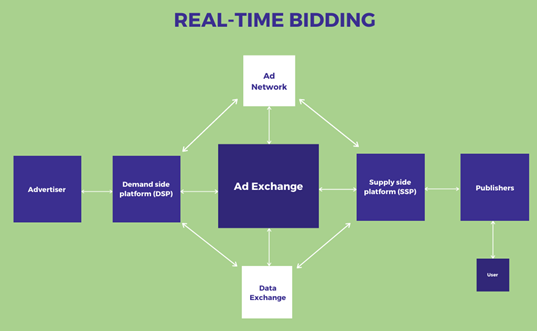Real time bidding (RTB) is a real-time auction by which advertising inventory is bought by advertisers and sold by publishers on a per-impression basis. It has become one of the most important parts of modern online advertising, surpassing previous, less efficient ways of connecting online publishers and advertisers.
RTB with its precise targeting has made online advertising more efficient for publishers as well as advertisers. It helps advertisers achieve better ROI on their marketing budgets, whereas through monetization of remnant ad inventory it contributes to higher revenues of publishers. These are just two of the many benefits of RTB for the online advertising ecosystem.

Figure 1: Real-time bidding process and its participants
Main participants in the real-time bidding process
RTB ecosystem consists of several types of parties that typically participate in the RTB process (see Figure 1):
- Publishers
- Supply-side platforms (SSP)
- Demand-side platforms (DSP)
- Ad exchanges
- Advertisers
Publishers
Publishers are websites visited by users and can range from personal blogs, mobile apps, news sites to social media platforms. Publishers possess advertising inventory, which they want to fill with ads in exchange for revenues from advertisers.
Supply-side platforms (SSPs)
Publishers sell, manage and optimize their online ads inventory with the help of the supply-side platforms. SSP dashboards allow publishers to control many aspects of their campaigns, including position, formats of ads, price per impression and other parameters. Most importantly, SSPs enable publishers to simultaneously offer ads on their webpages to many different ad exchanges and ad networks.
Well-known Supply-side platforms include:
- Google Ad Manager
- OpenX
- AppNexus SSP
- Rubicon Project
- PubMatic
- Oath (combines BrighRoll, ONE by AOL, Yahoo Gemini)
- SmartyAds SSP
Demand Side Platforms (DSPs)
Demand-side platforms play a similar role for advertisers as SSPs do for publishers. They are automation tools which allow advertisers to effectively manage, analyse, optimize and run their advertising campaigns over many different networks.
DSPs provide advertisers with a wide range of features – access to large ad inventory, precise targeting of users, single dashboard to manage campaigns across many different networks, real-time bidding on ads, their tracking and sophisticated ad optimization.
As part of the ad process, DSPs often provide their advertisers with additional data from third-party providers and enable them to complement this data with data from advertisers own systems. Real-time aspect of campaign management with the help of DSPs allows advertisers to obtain feedback, analyse Key Performance Indicators (KPIs) and adjust campaign parameters and targets in real-time.
Other important advantages of DSPs for advertisers include expanding their geographical reach and advanced options such as frequency capping (controlling the maximum number of times a user sees the same ad).
Ad Exchanges
Ad Exchanges are autonomous platforms where publishers can sell their ad inventory and advertisers can buy it. Publishers use SSPs to connect to Ad Exchanges and make their ad inventory available on them. On the other side of the process, the advertisers use DSPs to manage their marketing campaigns by connecting with and purchasing ads on Ad Exchanges.
Also interacting with Ad Exchanges are Ad Networks which aggregate ad inventory on ad exchanges, segment it according to demographics, context and other criteria and sell it to advertisers for commission. When compared to financial securities ecosystem, Ad Networks play a similar role as brokers do in securities trading.
Ad Exchanges offer many benefits for both publishers and advertisers. They provide publishers with a way to manage ad position on websites, ad formats, customized styling, such as fonts, colors and other parameters. They also allow them to manage CPMs, apply sophisticated filtering and sell excess ad inventory.
Ad Exchanges operate by having ad inventory of publishers made available on Exchange platform via their SSP. When a user visits a webpage, data about the user is sent from the publisher to the Ad Exchange via SSP. The latter sends an ad request to DSPs and Ad Networks which, if deciding to bid on ad, send the bids with maximum bid value along with location of advertising content.
Ad Exchange then reviews the received bids, removing those that are outside of publishers’ criteria. Next, it selects the auction winner and the corresponding advertising content appears on the publisher webpage.
Advertisers
Advertisers are persons, brands, organizations and other entities that pay to have their ad content placed on the properties of publishers in order to advertise and promote their products or services to target audience.
Real-time bidding process
Every time a user visits a webpage, an ad request is transmitted to ad exchanges either through an ad network or a supply side platform (SSP). The ad request from SSPs typically includes user demographic information, browsing history as well as the information about the webpage.
The ad exchange then sends queries to the demand side platforms (DSP), asking for advertisers’ bids. Demand side platform bids on impression based on its perceived value for the advertiser. Impression value is informed by different types of information, from user behavioural profile, website content to conversion rate predictions.
Advertisers’ bids are sent to ad exchanges, which select the winner of the auction. The final winner is selected at SSP in case the bid request was sent to more than one ad exchange. After the winning ad is selected, it is displayed on the webpage of the visiting user. The complete process, from user visiting the webpage to the final display of ad usually takes less than 100 milliseconds.
RTB auction is similar to the functioning of financial markets and their exchanges, except that ad impressions are being traded instead of stocks or fixed income securities. In terms of pricing, publishers determine the floor prices of ads, with transaction prices fluctuating based on supply and demand.
The important feature of the RTB process is its focus on the users, in contrast to other forms of advertising which can focus on the content and topics of publisher’s webpages. This targeted advertising brings considerable benefit for the advertisers and is the reason why we often see ads for stores that we may have visited earlier but have not converted at the time, “following” us as we visit other web sites.
Real-time bidding differs from static auctions where advertisers can only bid for several thousand impressions in single package deals. This makes static auctions less efficient than RTB for advertisers as well as publishers.
Difference between Real Time Bidding and Programmatic Advertising
Programmatic advertising and real-time bidding are important terms of the online advertising ecosystem and although they are sometimes used interchangeably, they are not identical. Real-time bidding is automated and thus is always a type of programmatic advertising, but not all programmatic advertising is real-time bidding.
Benefits of real-time bidding
Half of the money I spend on advertising is wasted; the trouble is I do not which half.
John Wannamaker (1838-1922), Father of modern advertising, pioneer in marketing
Benefits of RTB for Advertisers and Publishers
Real-time bidding allows advertisers to bid on individual impressions. As supplemental information is provided for each offered impression, its perceived value for advertiser can be more precisely calculated, leading to more cost-effective marketing campaigns. Through analysing results of marketing campaigns on individual or aggregated impressions, advertisers can gain important insights on important drivers for their KPIs.
With RTB, the marketing departments can avoid spending marketing resources on purchases of block ad inventory with non-targeted and thus often irrelevant users. Frequency capping enables advertisers to limit the number of times a user is exposed to the same ad.
RTB is a real-time process, which gives advertisers ability to monitor, analyse, optimize and adjust their marketing campaigns in real-time.
Brand safety has become an important concern for advertisers in recent years and some participants offer advertisers better brand safety through RTB by using technologies which prevent their advertising content being shown on unsuitable websites or next to inappropriate content.
There are also many considerable benefits of real-time bidding for publishers. One is generation of revenue from remnant ad inventory. With SSP platforms, publishers can also control which advertisers can buy and place ads on publishers’ websites. Another key benefit of SSP software is that it allows publishers to better control pricing of their ad inventory, e.g. through using floor prices.
Conclusion
Real-time bidding has become one of the main parts of modern online advertising, surpassing previous, less efficient ways of connecting online publishers and the advertisers.
Real-time bidding processes happen almost any time we visit a webpage or a mobile app with the ads that we see being decided in less than 100 milliseconds. This happens through auctions on Ad Exchanges, where publishers offer their ad inventory and advertisers bid on them, with winners’ ads finally shown to the visiting user.
RTB with its precise targeting has made online advertising more effective for both publishers and advertisers. It helps advertisers achieve better ROI on their marketing budgets, whereas through monetization of remnant ad inventory it helped increase the revenues of publishers. These are just two of the many benefits of RTB for the online advertising ecosystem.
Analytical firms forecast bright future for RTB in the years ahead. One report estimated that the global RTB will grow at 32.9% CAGR in the period 2019-2024, from 6.6 billion USD in 2019 to 27.2 billion USD in 2024, driven mainly by strong growth in smartphone users and better ROIs.



